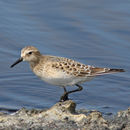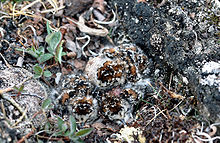en
names in breadcrumbs


Although this small (7-7 ½ inches) shorebird undertakes a remarkable long-distance migration each year, Baird’s Sandpiper is somewhat less remarkable in terms of physical appearance. Dull gray-brown above with a medium-length bill, black legs, and faint eye-stripe, Baird’s Sandpiper is easily confused with many similar-looking species of sandpiper that occur in its range and on migration. With the help of a high-powered field scope, this species may be identified by its long wings and lack of a white rump patch. In winter, this species’ plumage becomes less distinct, adding another layer of confusion to its identification. Male and female Baird’s Sandpipers are similar at all seasons. Baird’s Sandpiper breeds primarily in northern Alaska and on islands in arctic Canada. This species undertakes a fast-paced migration in which it traverses the entire continent of North America in the space of a few weeks. Baird’s Sandpiper winters in central and southern South America. In the breeding season, Baird’s Sandpiper inhabits relatively dry stretches of tundra. On migration, this species may be found for short periods of time in various kinds of freshwater wetlands. During the winter, this species inhabits damp fields and grasslands. Insects make up a large portion of the diet of Baird’s Sandpiper, which picks them off the ground, but small crustaceans may also be consumed. Due to its remote breeding habitat, most birdwatchers never see Baird’s Sandpiper during the summer. Similarly, many North American birdwatchers never travel far enough south to see this species during the winter. Most sightings in temperate regions of North America take place during the spring and fall, when this species may be seen in small numbers near water. Baird’s Sandpiper is primarily active during the day.
Although this small (7-7 ½ inches) shorebird undertakes a remarkable long-distance migration each year, Baird’s Sandpiper is somewhat less remarkable in terms of physical appearance. Dull gray-brown above with a medium-length bill, black legs, and faint eye-stripe, Baird’s Sandpiper is easily confused with many similar-looking species of sandpiper that occur in its range and on migration. With the help of a high-powered field scope, this species may be identified by its long wings and lack of a white rump patch. In winter, this species’ plumage becomes less distinct, adding another layer of confusion to its identification. Male and female Baird’s Sandpipers are similar at all seasons. Baird’s Sandpiper breeds primarily in northern Alaska and on islands in arctic Canada. This species undertakes a fast-paced migration in which it traverses the entire continent of North America in the space of a few weeks. Baird’s Sandpiper winters in central and southern South America. In the breeding season, Baird’s Sandpiper inhabits relatively dry stretches of tundra. On migration, this species may be found for short periods of time in various kinds of freshwater wetlands. During the winter, this species inhabits damp fields and grasslands. Insects make up a large portion of the diet of Baird’s Sandpiper, which picks them off the ground, but small crustaceans may also be consumed. Due to its remote breeding habitat, most birdwatchers never see Baird’s Sandpiper during the summer. Similarly, many North American birdwatchers never travel far enough south to see this species during the winter. Most sightings in temperate regions of North America take place during the spring and fall, when this species may be seen in small numbers near water. Baird’s Sandpiper is primarily active during the day.
Baird's sandpiper (Calidris bairdii) is a small shorebird. It is among those calidrids which were formerly included in the genus Erolia, which was subsumed into the genus Calidris in 1973.[2] The genus name is from Ancient Greek kalidris or skalidris, a term used by Aristotle for some grey-coloured waterside birds. The English name and specific bairdii commemorate Spencer Fullerton Baird, 19th-century naturalist and assistant secretary of the Smithsonian Institution.[3]
Adults have black legs and a short, straight, thin dark bill. They are dark brown on top and mainly white underneath with a black patch on the rump. The head and breast are light brown with dark streaks. In winter plumage, this species is paler brownish gray above. This bird can be difficult to distinguish from other similar tiny shorebirds; these are known collectively as "peeps" or "stints".
One of the best identification features is the long wings, which extend beyond the tail when the bird is on the ground. Only the white-rumped sandpiper also shows this, and that bird can be distinguished by its namesake feature.

Baird's sandpipers breed in the northern tundra from eastern Siberia to western Greenland. They nest on the ground, usually in dry locations with low vegetation.
They are a long-distance migrant, wintering in South America. This species is a rare vagrant to western Europe.
Baird's sandpiper might have hybridized with the buff-breasted sandpiper.
These birds forage by moving about mudflats, picking up food by sight. They mainly eat insects, also some small crustaceans.
Baird's sandpiper (Calidris bairdii) is a small shorebird. It is among those calidrids which were formerly included in the genus Erolia, which was subsumed into the genus Calidris in 1973. The genus name is from Ancient Greek kalidris or skalidris, a term used by Aristotle for some grey-coloured waterside birds. The English name and specific bairdii commemorate Spencer Fullerton Baird, 19th-century naturalist and assistant secretary of the Smithsonian Institution.